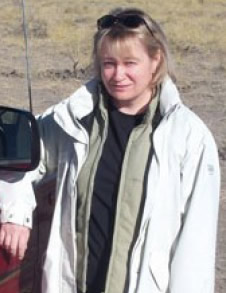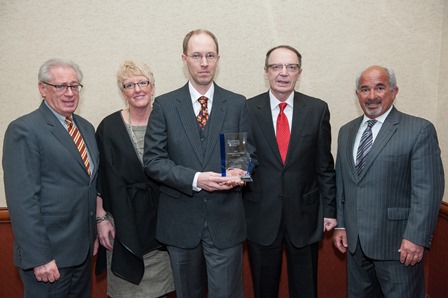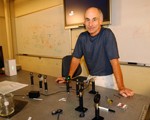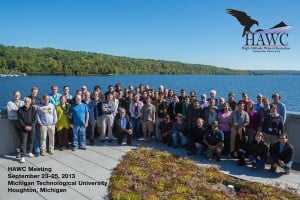 Members of the High Altitute Water Cherenkov (HAWC) Gamma-Ray Observatory met at Michigan Tech on September 23-25, 2013. The meeting was attended by about 60 international members. The meeting was coordinated by Assistant Professor of Physics Petra H. Huentemeyer.
Members of the High Altitute Water Cherenkov (HAWC) Gamma-Ray Observatory met at Michigan Tech on September 23-25, 2013. The meeting was attended by about 60 international members. The meeting was coordinated by Assistant Professor of Physics Petra H. Huentemeyer.
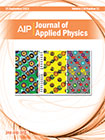 Professors John Jaszczak (Physics) and Paul Bergstrom (ECE), with PhD students Madhusudan Savaikar and Douglas Banyai, published a paper, “Simulation of charge transport in multi-island tunneling devices: Application to disordered one-dimensional systems at low and high biases” in the latest issue of Journal of Applied Physics (vol. 114 issue 11).
Professors John Jaszczak (Physics) and Paul Bergstrom (ECE), with PhD students Madhusudan Savaikar and Douglas Banyai, published a paper, “Simulation of charge transport in multi-island tunneling devices: Application to disordered one-dimensional systems at low and high biases” in the latest issue of Journal of Applied Physics (vol. 114 issue 11).
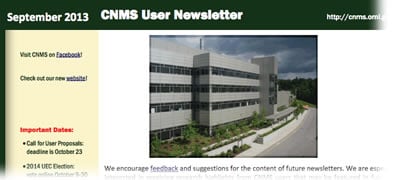
Recent work published by Professor Yoke Khin Yap (Physics) on transistors without semiconductors has gained attention at the Center for Nanophase Materials Sciences (CNMS) at Oak Ridge National Laboratory (ORNL). Yap’s work “Room Temperature Tunneling Behaviors of Boron Nitride Nanotubes Functionalized with Gold Quantum Dots,” first appeared in CNMS Research Highlights, and then later in the September issue of the CNMS User Newsletter.
This work is now being highlighted by Dr. Sean Smith, Director of CNMS, during his overview talk in the Triennial Review of CNMS. The triennial review is being held on September 24-26, 2013 at CNMS as attended by the review team of the U.S. Department of Energy, the CNMS Advisory Committee Review Panel, and scientists in CNMS.
On September 25, Professor Yap presented an invited talk entitled “Transistors without semiconductors: tunneling behavior of functional boron nitride nanotubes” during the review. The highlights are related to a Yap article recently published in Volume 25, Issue 33/2013, pages 4544-4548 of Advanced Materials (http://onlinelibrary.wiley.com/doi/10.1002/adma.201301339/abstract).
Yap’s coauthors include Professor John Jaszczak, research scientist Dongyan Zhang, postdoctoral researchers Chee Huei Lee and Jiesheng Wang, and graduate students Madhusudan A. Savaikar, Boyi Hao and Douglas Banyai of Michigan Tech; Shengyong Qin, Kendal W. Clark and An-Ping Li of the Center for Nanophase Materials Sciences at ORNL; and Juan-Carlos Idrobo of the Materials Science and Technology Division of ORNL.
Dr. Debasis Datta was inducted into Michigan Technological University’s Academy of Sciences and Arts on September 13, 2013. Datta graduated with a PhD in Physics from Michigan Technological University in 1994. His research work at Tech resulted in ten publications in American Physical Review. Following the completion of his postdoctoral work, he started his career in Information Technology in 1996 as a software engineer in the IT services industry. During his 16 year IT career, Debasis worked at DaimlerChrysler, PeopleSoft, Oracle and General Motors Corporation where he is currently employed.
Read more from the Dean’s Comments at the 2013 induction ceremony.
View the PHOTO GALLERY.
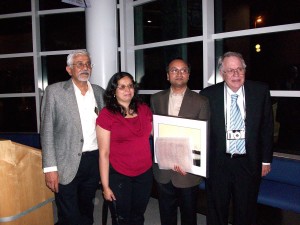
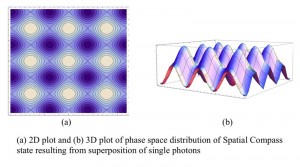 Title: Intrinsic Correlations of Quantum Lights in Macroscopic Environments
Title: Intrinsic Correlations of Quantum Lights in Macroscopic Environments
Advisor: Dr. Kim Fook Lee
Co-Advisor: Dr. Jacek Borysow
Quantum Information Science (QIS) is an up-and-coming field that exploits the peculiar properties of quantum superposition and entanglement by using quantum objects, such as atoms, molecules, photons and phonons. As photons interact weakly with their environment and are very robust against environmental disturbance, they are considered the most promising candidates for the applications of QIS. The preservation of intrinsic quantum properties of light in macroscopic environments will be the key for practical realization of QIS. For my Ph.D. research, I’m working with different quantum light sources, spanning from single photon systems such as entangled photons to millions of photons such as weak coherent light. I study the intrinsic correlations of quantum light in macroscopic environments, while mainly concerned with their applications in quantum metrology and communications.
by Yong Meng Sua
References:
- Y. M. Sua, J. Malowicki, and K. F. Lee, “Quantum Correlation of Telecom Wavelength Photon-pair through Multiple Scattering Media,” in The Rochester Conferences on Coherence and Quantum Optics and the Quantum Information and Measurement meeting, OSA Technical Digest (online) (Optical Society of America, 2013), paper W6.27.
- Y. M. Su, J. Malowicki, M. Hirano, and K. F. Lee, “Generation of high purity entangled photon-pair in a short highly non-linear fiber,” Optics Letters, 38, 73-75 (2013)
- Y. M. Sua and K. F. Lee, “Macroscopic mechanical correlations using single-photon spatial compass state and operational Wigner function,” Phys. Rev. A 85, 062113 (2012).
- Y. M. Sua, E. Scanlon, T. Beaulieu, V. Bollen, and K. F. Lee, “Intrinsic quantum correlations of weak coherent states for quantum communication,” Phys. Rev. A 83, 030302(R) (2011).
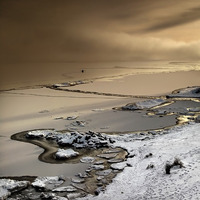 “A Minimalist Approach to Modeling Complex Arctic Clouds” was submitted by Dr. Raymond Shaw to Research Highlights in Atmospheric System Research (ASR), US Department of Energy. The highlight is based on the publication Yang F, M Ovchinnikov, and RA Shaw. 2013. “Minimalist model of ice microphysics in mixed-phase stratiform clouds.” Geophysical Research Letters, 40(14), doi:10.1002/grl.50700. The highlight concerns mixed-phase stratiform clouds, which are common features in the Arctic environment.
“A Minimalist Approach to Modeling Complex Arctic Clouds” was submitted by Dr. Raymond Shaw to Research Highlights in Atmospheric System Research (ASR), US Department of Energy. The highlight is based on the publication Yang F, M Ovchinnikov, and RA Shaw. 2013. “Minimalist model of ice microphysics in mixed-phase stratiform clouds.” Geophysical Research Letters, 40(14), doi:10.1002/grl.50700. The highlight concerns mixed-phase stratiform clouds, which are common features in the Arctic environment.
Read more at ASR Research Highlights.
Last spring Will Cantrell was named a 2013 Michigan Distinguished Professor of the Year by the President’s Council, State Universities of Michigan. Cantrell was recognized for his outstanding contributions and dedication to the education of undergraduate students.
The President’s Council has posted a photo gallery of the award presentation event, which included Michigan Tech Provost Max Seel and co-recipients of the award.
Learn more about teaching award recipients from the Department of Physics at Michigan Tech.
